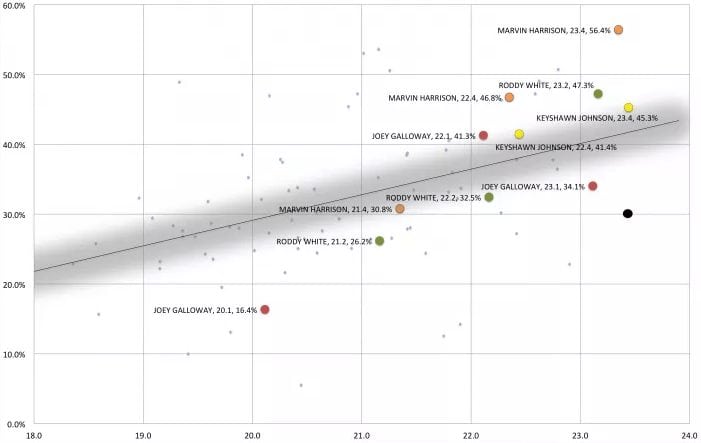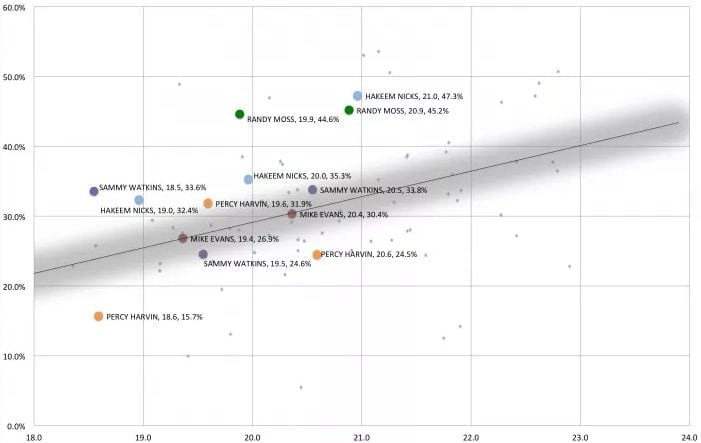Cover 3 is a weekly feature column written by PewterReport.com’s Tampa Bay Buccaneers beat writer Trevor Sikkema published every Tuesday. The column, as its name suggests, comes in three phases: a statistical observation, an in-depth film breakdown, and a “this or that” segment where the writer asks the reader to chose between two options.
SIKKEMA’S STAT OF THE WEEK
Age is just a number, right?
Well, when it comes to the NFL Draft, it’s not as black and white as you’d expect, but it’s also not something to take lightly either.
In years past, we’ve heard people talk about how players like wide receiver Kelvin Benjamin are less coveted players because of their older ages – he was 24 years old during his rookie seasons. But to counter that, I saw many people (smart people, I may add) argue the point of, “who cares?” when it comes to age with Top 100 prospects.
I would say that neither side is completely correct. You never want to just throw a player out because he’s on the older side, but it’s also ignorant to believe that age, relative to their collegiate production, doesn’t have something to do with predicting how their success will translate to the NFL.
Jon Moore of Rotoviz wrote and article a while back that explained the age conundrum pretty well for the wide receiver position. In it, he established that a player’s market share, or individual production relative to the team’s total production, is the tool to use when determining whether or not a player’s age should be a concern.
The examples he chose to use with wide receivers were a couple of former Bucs in Keyshawn Johnson and Joey Galloway, in addition to Marvin Harrison and Roddy White – all players who were 24 years old in their rookie seasons. Moore notes that all four of those players had good NFL careers. So, what he did was compare the collegiate production of those four players to the averaged market share production they had in college with all wide receivers who were considered above-average in the NFL.

The main takeaway from that chart is that the average slope for market share production in college for wide receivers who are successful in the NFL starts at right above 20 percent at age 18 and is between 40 and 45 percent for receivers who were still in school between ages 23 and 24.
What that boils down to is the emphasis and biggest takeaway from the age-production metric. It is not a bad thing for a wide receiver to be older, but there is something to be said about dominance at each age. If a player is commanding more than 20-25 percent of his team’s market share at age 18 and 19, that should be viewed as on track for NFL success – those aren’t my words or even Moore’s, those are historical numbers saying that. Similarly, statistics show that players between 23 and 24 years old are not commanding above 40 percent of their team’s market share success, chances are they don’t have the skills to make it in the NFL.
Now, there are certainly cases where this metric could be skewed. For example, if one receiver is on a team that is schemed incorrectly for their skill, such as Air Force wide receiver Jalen Robinette, who is a very good receiver on a run-first team that deploys the option, that could affect the truthfulness of the metric in their situation. However, the averages are what they are for a reason.
Moore also did a specific chart to single out how it was right on schedule that Buccaneers wide receiver Mike Evans was having such early success in the NFL base on his market share while at Texas A&M.

The chart above compares Evans to other elite, 21-year-old wide receivers throughout the NFL’s history. The chart put Evans right on par with the other great young NFL receivers based on the fact that his production and reliability went up at the correct rate while at Texas A&M relative to how old he was when he was commanding such output.
So you can see there’s some truth to all this. It’s not that a player has to be below a certain age to be successful, but history tells us that there are certain thresholds that need to be met in order to predict success.
This age metric isn’t just for the wide receiver position either. Jim Cobern is a master of metric in his own right, and has established production, athleticism and age scores that players must hit in order to be considered All-Pro predictions by going through the data for every single player drafted since the 1987 draft.
In it, he explains that determining potential seriously favors those who have the talent to make it to the NFL at a young age – sort of a “duh”, but many people fail to use age as the tool it is. Of the edge rushers who became long-term starters, 79 percent of them were below the average age of their edge rushing classmates in whatever year they were drafted. In fact, of the All-Pro edge rushers who were drafted since the 1987 draft, 82.66 percent of them were below that average draft age of whatever class they were in.
“Every multiple All-Pro to Pro Bowl Edge Rusher since the 1987 NFL Draft class were above average in age on their draft day compared to their 877 Edge Rusher peers.”
At the end of the day, age may be just a number, but that number can be just as much of a factor as those other numbers we love to score like height, weight, hand size, 40-yard dash time, etc. Being an older player is fine as long as a player has the correct production output to go along with it.
I think Cobern put it perfectly when he said this,


